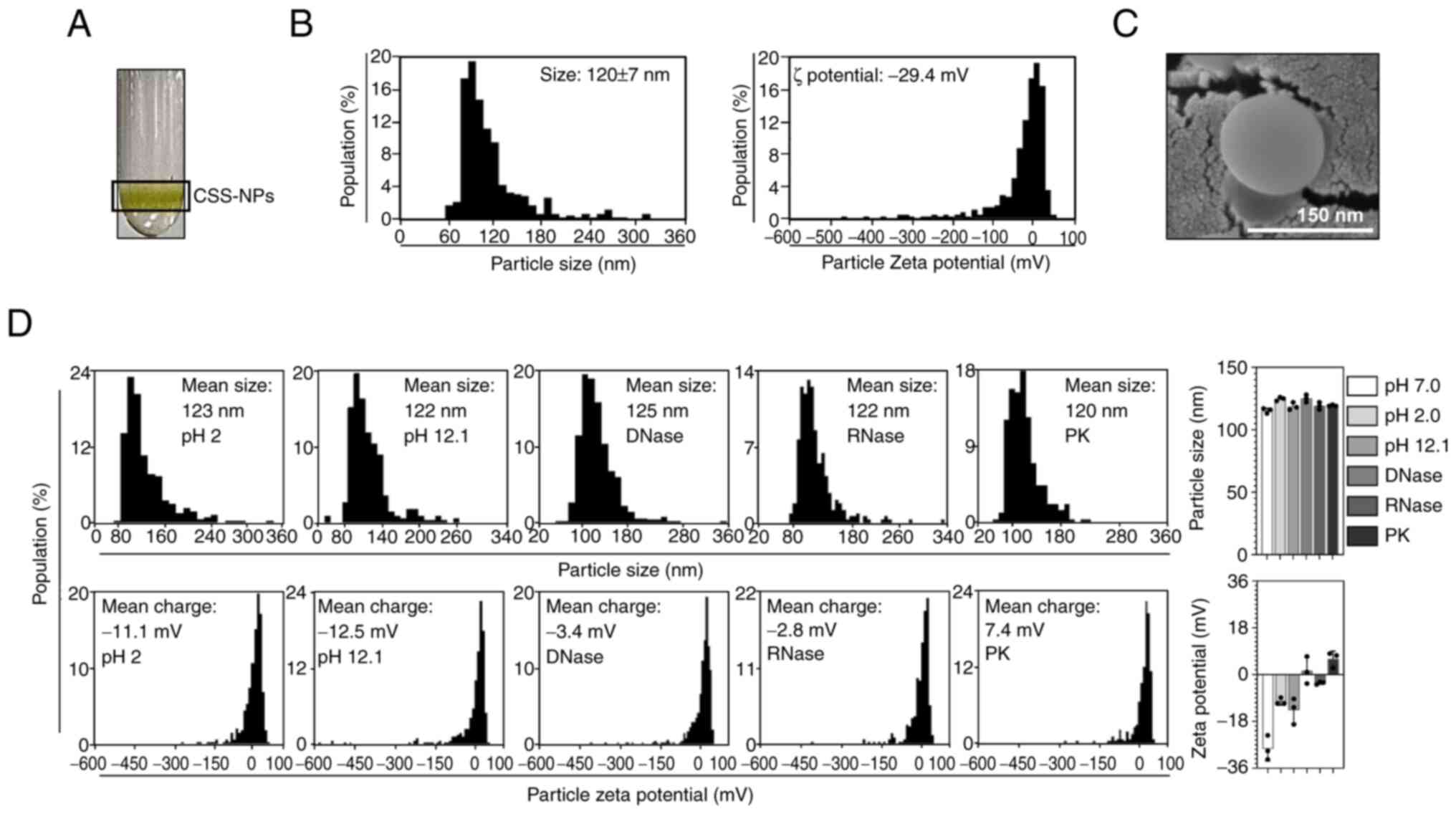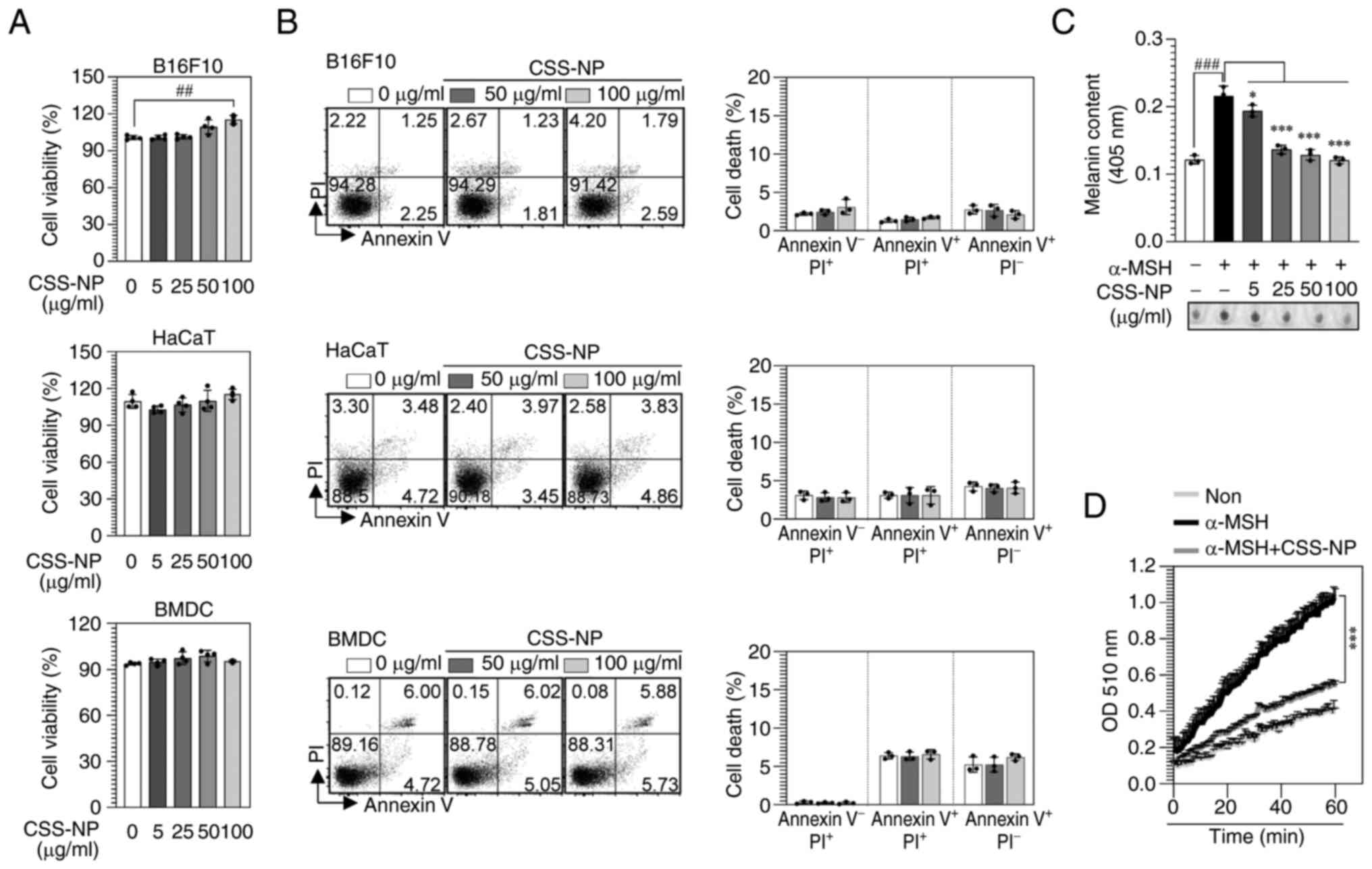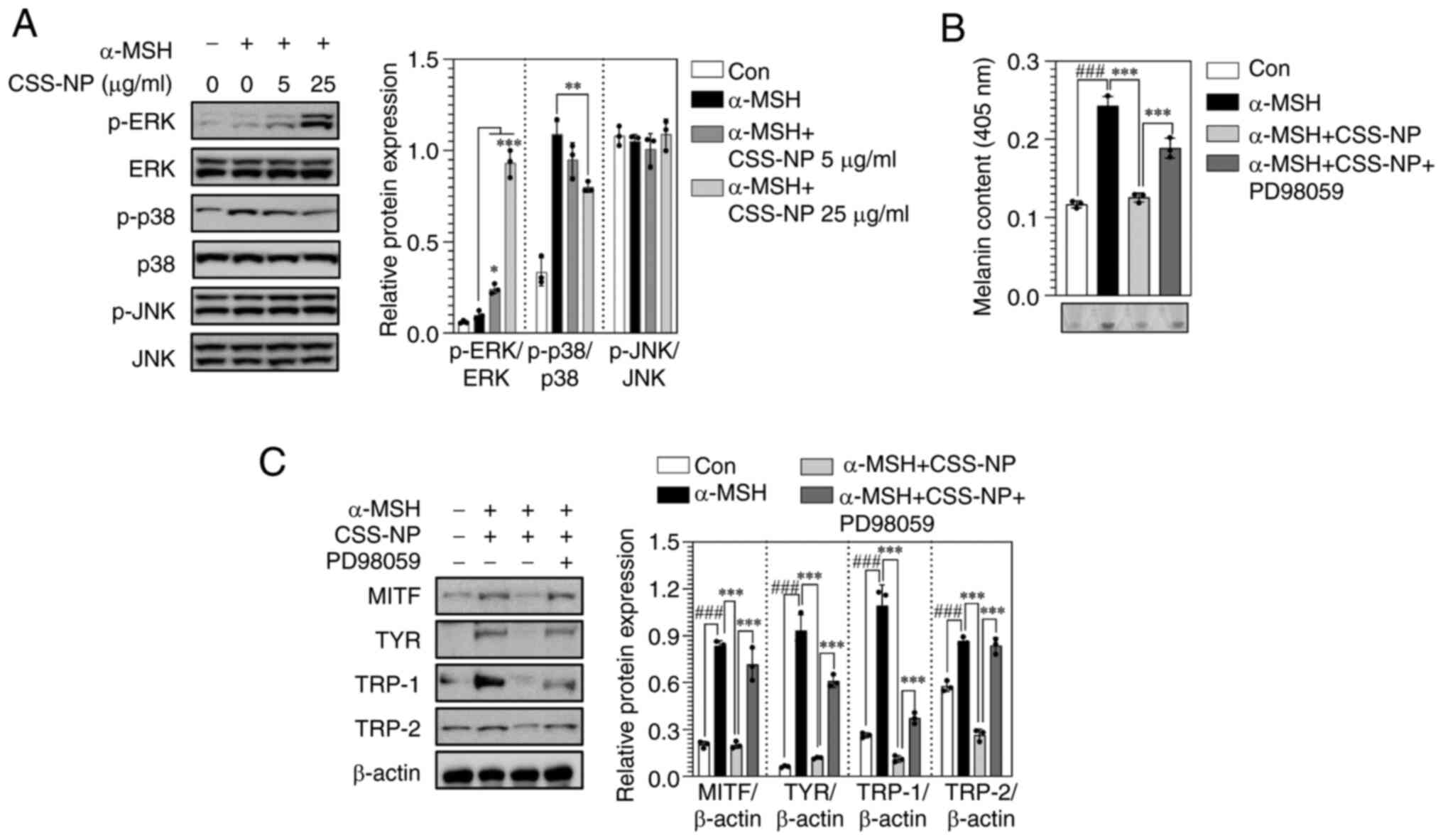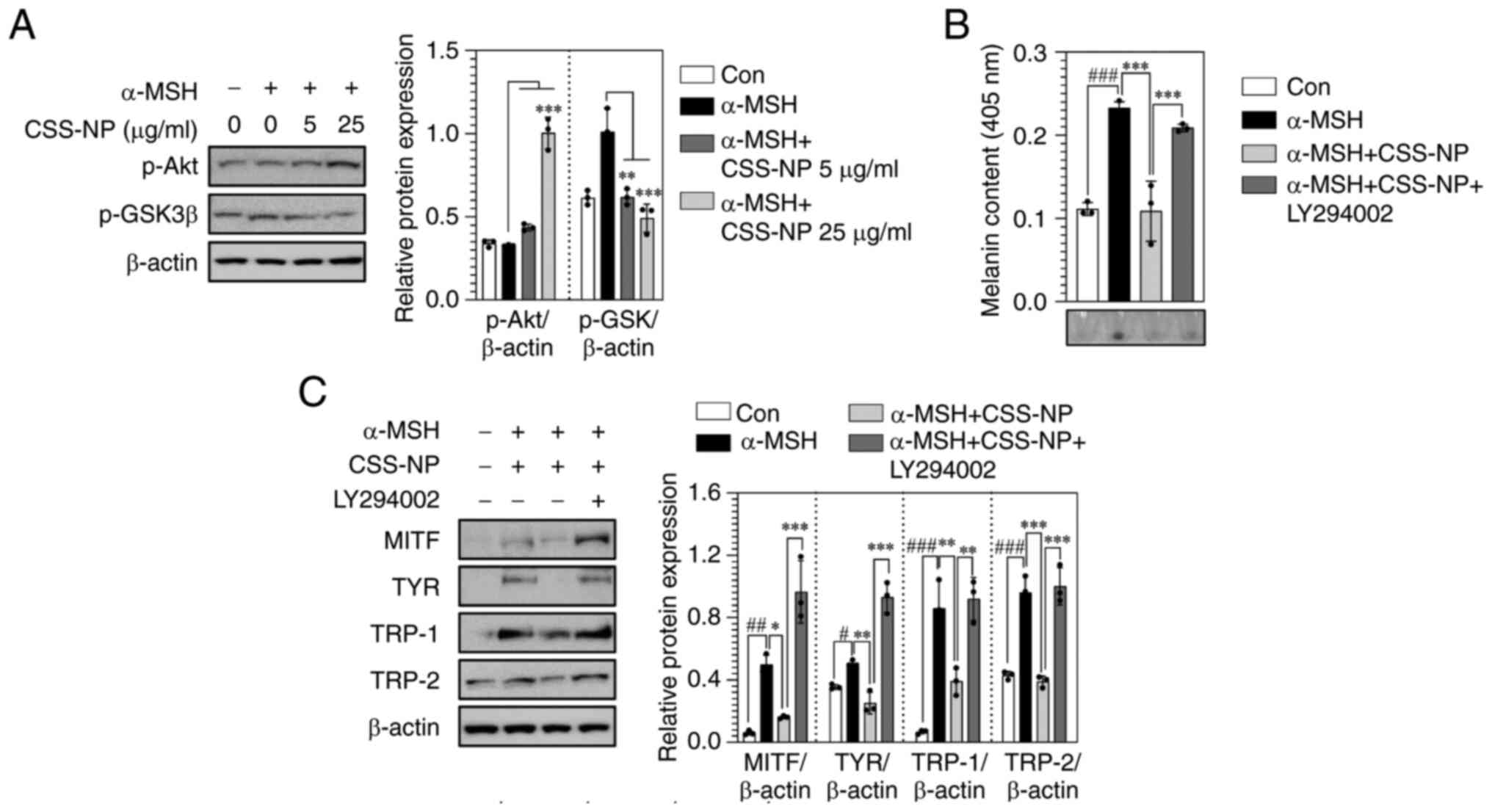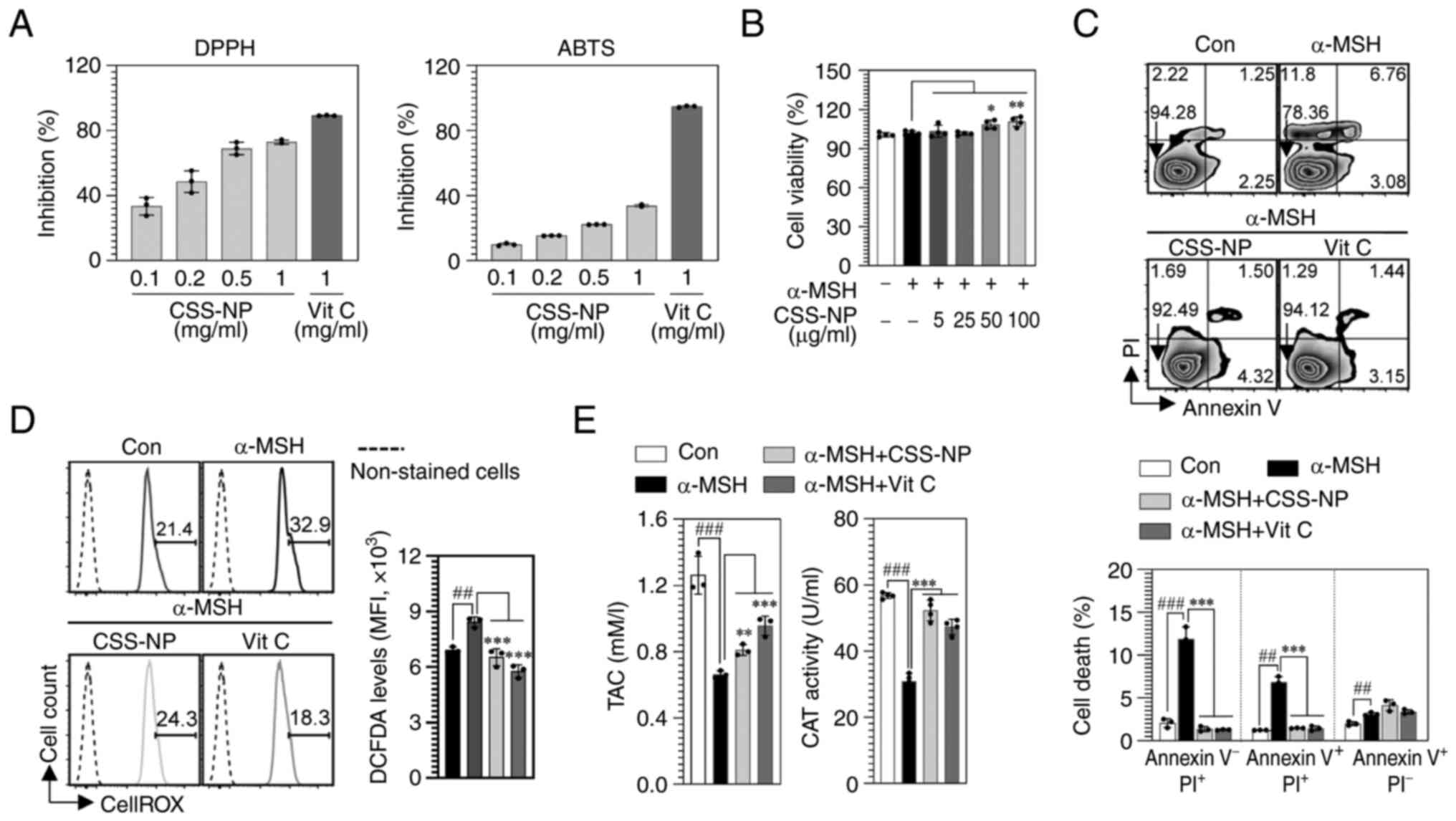|
1
|
D'Mello SA, Finlay GJ, Baguley BC and
Askarian-Amiri ME: Signaling pathways in melanogenesis. Int J Mol
Sci. 17:11442016. View Article : Google Scholar : PubMed/NCBI
|
|
2
|
Solano F: Photoprotection and skin
pigmentation: Melanin-Related molecules and some other new agents
obtained from natural sources. Molecules. 25:15372020. View Article : Google Scholar : PubMed/NCBI
|
|
3
|
Lee A, Kim JY, Heo J, Cho DH, Kim HS, An
IS, An S and Bae S: The inhibition of melanogenesis via the PKA and
ERK signaling pathways by chlamydomonas reinhardtii extract in
B16F10 melanoma cells and artificial human skin equivalents. J
Microbiol Biotechnol. 28:2121–2132. 2018. View Article : Google Scholar : PubMed/NCBI
|
|
4
|
Sarkar R, Arora P and Garg KV:
Cosmeceuticals for hyperpigmentation: What is available? J Cutan
Aesthet Surg. 6:4–11. 2013. View Article : Google Scholar : PubMed/NCBI
|
|
5
|
Pillaiyar T, Manickam M and Namasivayam V:
Skin whitening agents: Medicinal chemistry perspective of
tyrosinase inhibitors. J Enzyme Inhib Med Chem. 32:403–425. 2017.
View Article : Google Scholar : PubMed/NCBI
|
|
6
|
Solano F, Briganti S, Picardo M and Ghanem
G: Hypopigmenting agents: An updated review on biological, chemical
and clinical aspects. Pigment Cell Res. 19:550–571. 2006.
View Article : Google Scholar : PubMed/NCBI
|
|
7
|
Kooyers T and Westerhof W: Toxicology and
health risks of hydroquinone in skin lightening formulations. J
European academy of Dermatology and Venereology. 20:777–780. 2006.
View Article : Google Scholar
|
|
8
|
Sarasati A, Syahruddin MH, Nuryanti A, Ana
ID, Barlian A, Wijaya CH, Ratnadewi D, Wungu TDK and Takemori H:
Plant-derived exosome-like nanoparticles for biomedical
applications and regenerative therapy. Biomedicines. 11:10532023.
View Article : Google Scholar : PubMed/NCBI
|
|
9
|
Sall IM and Flaviu TA: Plant and
mammalian-derived extracellular vesicles: A new therapeutic
approach for the future. Front Bioeng Biotechnol. 11:12156502023.
View Article : Google Scholar : PubMed/NCBI
|
|
10
|
Lian MQ, Chng WH, Liang J, Yeo HQ, Lee CK,
Belaid M, Tollemeto M, Wacker MG, Czarny B and Pastorin G:
Plant-derived extracellular vesicles: Recent advancements and
current challenges on their use for biomedical applications. J
Extracell Vesicles. 11:e122832022. View Article : Google Scholar : PubMed/NCBI
|
|
11
|
Ju S, Mu J, Dokland T, Zhuang X, Wang Q,
Jiang H, Xiang X, Deng ZB, Wang B, Zhang L, et al: Grape
exosome-like nanoparticles induce intestinal stem cells and protect
mice from DSS-induced colitis. Mol Ther. 21:1345–1357. 2013.
View Article : Google Scholar : PubMed/NCBI
|
|
12
|
Wang B, Zhuang X, Deng ZB, Jiang H, Mu J,
Wang Q, Xiang X, Guo H, Zhang L, Dryden G, et al: Targeted drug
delivery to intestinal macrophages by bioactive nanovesicles
released from grapefruit. Mol Ther. 22:522–534. 2014. View Article : Google Scholar : PubMed/NCBI
|
|
13
|
Li DF, Tang Q, Yang MF, Xu HM, Zhu MZ,
Zhang Y, Tian CM, Nie YQ, Wang JY, Liang YJ, et al: Plant-derived
exosomal nanoparticles: Potential therapeutic for inflammatory
bowel disease. Nanoscale Adv. 5:3575–3588. 2023. View Article : Google Scholar : PubMed/NCBI
|
|
14
|
Choi W, Cho JH, Park SH, Kim DS, Lee HP,
Kim D, Kim HS, Kim JH and Cho JY: Ginseng root-derived exosome-like
nanoparticles protect skin from UV irradiation and oxidative stress
by suppressing activator protein-1 signaling and limiting the
generation of reactive oxygen species. J Ginseng Res. 48:211–219.
2024. View Article : Google Scholar : PubMed/NCBI
|
|
15
|
Kim M, Jang H, Kim W, Kim D and Park JH:
Therapeutic applications of plant-derived extracellular vesicles as
antioxidants for oxidative stress-related diseases. Antioxidants
(Basel). 12:12862023. View Article : Google Scholar : PubMed/NCBI
|
|
16
|
Morgan C and Nigam Y: Naturally derived
factors and their role in the promotion of angiogenesis for the
healing of chronic wounds. Angiogenesis. 16:493–502. 2013.
View Article : Google Scholar : PubMed/NCBI
|
|
17
|
Roleira FM, Tavares-da-Silva EJ, Varela
CL, Costa SC, Silva T, Garrido J and Borges F: Plant derived and
dietary phenolic antioxidants: Anticancer properties. Food Chem.
183:235–258. 2015. View Article : Google Scholar : PubMed/NCBI
|
|
18
|
Cui X, Lin Q and Liang Y: Plant-derived
antioxidants protect the nervous system from aging by inhibiting
oxidative stress. Front Aging Neurosci. 12:2092020. View Article : Google Scholar : PubMed/NCBI
|
|
19
|
Hussain T, Jeena G, Pitakbut T, Vasilev N
and Kayser O: Cannabis sativa research trends, challenges, and
new-age perspectives. iScience. 24:1033912021. View Article : Google Scholar : PubMed/NCBI
|
|
20
|
Stasilowicz-Krzemien A, Sip S, Szulc P and
Cielecka-Piontek J: Determining antioxidant activity of cannabis
leaves extracts from different varieties-unveiling Nature's
Treasure Trove. Antioxidants (Basel). 12:13902023. View Article : Google Scholar : PubMed/NCBI
|
|
21
|
Koltai H and Shalev N: Anti-Cancer
activity of Cannabis Sativa Phytocannabinoids: Molecular mechanisms
and potential in the fight against ovarian cancer and stem cells.
Cancers (Basel). 14:42992022. View Article : Google Scholar : PubMed/NCBI
|
|
22
|
Zaiachuk M, Suryavanshi SV, Pryimak N,
Kovalchuk I and Kovalchuk O: The anti-inflammatory effects of
cannabis sativa extracts on LPS-induced cytokines release in human
macrophages. Molecules. 28:49912023. View Article : Google Scholar : PubMed/NCBI
|
|
23
|
Zagorska-Dziok M, Bujak T, Ziemlewska A
and Niziol-Lukaszewska Z: Positive effect of Cannabis sativa L.
Herb extracts on skin cells and assessment of Cannabinoid-Based
Hydrogels properties. Molecules. 26:8022021. View Article : Google Scholar : PubMed/NCBI
|
|
24
|
Kim WS, Ha JH, Jeong SH, Lee JI, Lee BW,
Jeong YJ, Kim CY, Park JY, Ryu YB, Kwon HJ and Lee I: Immunological
effects of aster yomena callus-derived extracellular vesicles as
potential therapeutic agents against allergic Asthma. Cells.
11:28052022. View Article : Google Scholar : PubMed/NCBI
|
|
25
|
Lee HJ, Shin KW, Lee SJ, Park JY, Lee IC,
Kwon HJ, Jeong HJ, Yuk JM, Ryu YB and Kim WS: Immunomodulation by
extracellular vesicle-like nanoparticles from marine macroalgae
Sargassum fusiforme: Enhancing type 1 T helper and cytotoxic T
lymphocyte-mediated immune responses. J Funct Foods.
112:1059812024. View Article : Google Scholar
|
|
26
|
Livak KJ and Schmittgen TD: Analysis of
relative gene expression data using real-time quantitative PCR and
the 2(−Delta Delta C(T)) method. Methods. 25:402–408. 2001.
View Article : Google Scholar : PubMed/NCBI
|
|
27
|
Blois MS: Antioxidant determinations by
the use of a stable free radical. Nature. 181:1199–1200. 1958.
View Article : Google Scholar
|
|
28
|
Re R, Pellegrini N, Proteggente A, Pannala
A, Yang M and Rice-Evans C: Antioxidant activity applying an
improved ABTS radical cation decolorization assay. Free Radic Biol
Med. 26:1231–1237. 1999. View Article : Google Scholar : PubMed/NCBI
|
|
29
|
Ou X, Wang H, Tie H, Liao J, Luo Y, Huang
W, Yu R, Song L and Zhu J: Novel plant-derived exosome-like
nanovesicles from Catharanthus roseus: Preparation,
characterization, and immunostimulatory effect via
TNF-alpha/NF-kappaB/PU.1 axis. J Nanobiotechnology. 21:1602023.
View Article : Google Scholar : PubMed/NCBI
|
|
30
|
Niu C and Aisa HA: Upregulation of
melanogenesis and tyrosinase activity: Potential agents for
Vitiligo. Molecules. 22:13032017. View Article : Google Scholar : PubMed/NCBI
|
|
31
|
El-Nashar HAS, El-Din MIG, Hritcu L and
Eldahshan OA: Insights on the inhibitory power of flavonoids on
tyrosinase activity: A survey from 2016 to 2021. Molecules.
26:75462021. View Article : Google Scholar : PubMed/NCBI
|
|
32
|
Lim JW, Ha JH, Jeong YJ and Park SN:
Anti-melanogenesis effect of dehydroglyasperin C through the
downregulation of MITF via the reduction of intracellular cAMP and
acceleration of ERK activation in B16F1 melanoma cells. Pharmacol
Rep. 70:930–935. 2018. View Article : Google Scholar : PubMed/NCBI
|
|
33
|
Cargnello M and Roux PP: Activation and
function of the MAPKs and their substrates, the MAPK-activated
protein kinases. Microbiol Mol Biol Rev. 75:50–83. 2011. View Article : Google Scholar : PubMed/NCBI
|
|
34
|
Jang JY, Lee JH, Kang BW, Chung KT, Choi
YH and Choi BT: Dichloromethane fraction of Cimicifuga
heracleifolia decreases the level of melanin synthesis by
activating the ERK or AKT signaling pathway in B16F10 cells. Exp
Dermatol. 18:232–237. 2009. View Article : Google Scholar : PubMed/NCBI
|
|
35
|
Emanuelli M, Sartini D, Molinelli E,
Campagna R, Pozzi V, Salvolini E, Simonetti O, Campanati A and
Offidani A: The double-edged sword of oxidative stress in skin
damage and melanoma: From physiopathology to therapeutical
approaches. Antioxidants (Basel). 11:6122022. View Article : Google Scholar : PubMed/NCBI
|
|
36
|
Nakai K and Tsuruta D: What are reactive
oxygen species, free radicals, and oxidative stress in skin
diseases? Int J Mol Sci. 22:107992021. View Article : Google Scholar : PubMed/NCBI
|
|
37
|
Ansary TM, Hossain MR, Kamiya K, Komine M
and Ohtsuki M: Inflammatory molecules associated with ultraviolet
radiation-mediated skin aging. Int J Mol Sci. 22:39742021.
View Article : Google Scholar : PubMed/NCBI
|
|
38
|
Kawakami A and Fisher DE: The master role
of microphthalmia-associated transcription factor in melanocyte and
melanoma biology. Lab Invest. 97:649–656. 2017. View Article : Google Scholar : PubMed/NCBI
|
|
39
|
Gelmi MC, Houtzagers LE, Strub T, Krossa I
and Jager MJ: MITF in normal melanocytes, cutaneous and uveal
melanoma: A delicate balance. Int J Mol Sci. 23:60012022.
View Article : Google Scholar : PubMed/NCBI
|
|
40
|
Ko GA and Cho SK: Phytol suppresses
melanogenesis through proteasomal degradation of MITF via the
ROS-ERK signaling pathway. Chem Biol Interact. 286:132–140. 2018.
View Article : Google Scholar : PubMed/NCBI
|
|
41
|
Cheng ZJ, Dai GF, Hsu JL, Lin JJ, Wu WT,
Su CC and Wu YJ: Antimelanogenesis effect of methyl gallate through
the regulation of PI3K/Akt and MEK/ERK in B16F10 melanoma cells.
Evid. Based Complement Alternat Med. 2022:50926552022.PubMed/NCBI
|
|
42
|
Chae JK, Subedi L, Jeong M, Park YU, Kim
CY, Kim H and Kim SY: Gomisin N inhibits melanogenesis through
regulating the PI3K/Akt and MAPK/ERK signaling pathways in
Melanocytes. Int J Mol Sci. 18:4712017. View Article : Google Scholar : PubMed/NCBI
|
|
43
|
Song YC, Lee Y, Kim HM, Hyun MY, Lim YY,
Song KY and Kim BJ: Berberine regulates melanin synthesis by
activating PI3K/AKT, ERK and GSK3β in B16F10 melanoma cells. Int J
Mol Med. 35:1011–1016. 2015. View Article : Google Scholar : PubMed/NCBI
|
|
44
|
Smejkal K, Slapetova T, Krmencik P, Babula
P, Dall'Acqua S, Innocenti G, Vančo J, Casarin E, Carrara M,
Kalvarová K, et al: Evaluation of cytotoxic activity of Schisandra
Chinensis Lignans. Planta Med. 76:1672–1677. 2010. View Article : Google Scholar : PubMed/NCBI
|
|
45
|
Singh N and Sharma B: Toxicological
effects of Berberine and Sanguinarine. Front Mol Biosci. 5:212018.
View Article : Google Scholar : PubMed/NCBI
|
|
46
|
Liu HM, Cheng MY, Xun MH, Zhao ZW, Zhang
Y, Tang W, Cheng J, Ni J and Wang W: Possible mechanisms of
oxidative stress-induced skin cellular senescence, inflammation,
and cancer and the therapeutic potential of plant polyphenols. Int
J Mol Sci. 24:37552023. View Article : Google Scholar : PubMed/NCBI
|
|
47
|
Wei M, He X, Liu N and Deng H: Role of
reactive oxygen species in ultraviolet-induced photodamage of the
skin. Cell Div. 19:12024. View Article : Google Scholar : PubMed/NCBI
|
|
48
|
Rodriguez-Casado A: The health potential
of fruits and vegetables phytochemicals: Notable examples. Crit Rev
Food Sci Nutr. 56:1097–1107. 2016. View Article : Google Scholar : PubMed/NCBI
|
|
49
|
Barbieri R, Coppo E, Marchese A, Daglia M,
Sobarzo-Sánchez E, Nabavi SF and Nabavi SM: Phytochemicals for
human disease: An update on plant-derived compounds antibacterial
activity. Microbiol Res. 196:44–68. 2017. View Article : Google Scholar : PubMed/NCBI
|
|
50
|
Gonzalez-Vallinas M, Gonzalez-Castejon M,
Rodriguez-Casado A and de Molina AR: Dietary phytochemicals in
cancer prevention and therapy: A complementary approach with
promising perspectives. Nutr Rev. 71:585–599. 2013. View Article : Google Scholar : PubMed/NCBI
|



